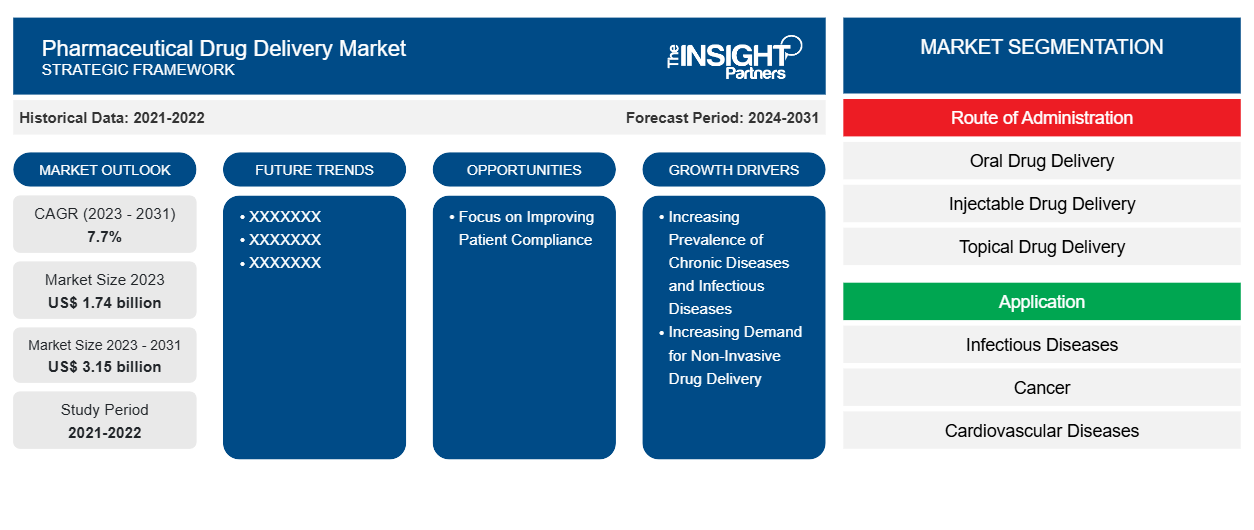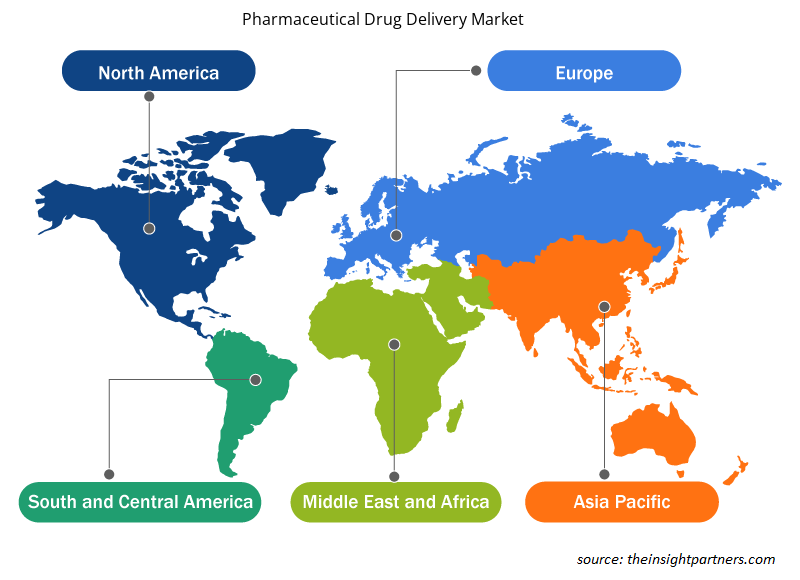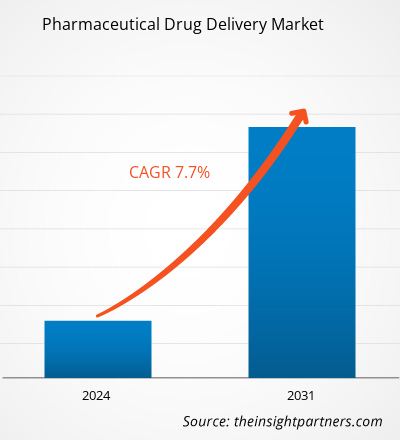The Pharmaceutical Drug Delivery Market size was estimated to be US$ 1.74 billion in 2023 and is expected to reach US$ 3.15 billion by 2031; it is estimated to record a CAGR of 7.7% till 2031. Strategic developments and product launches are likely to remain key Pharmaceutical Drug Delivery Market trends.
Pharmaceutical Drug Delivery Market Analysis
Increasing geriatric population, increasing home healthcare, increasing prevalence of chronic diseases, increasing surgical procedures, and increasing prevalence of infectious diseases is driving the growth of the pharmaceutical drug delivery market. In addition, increase in FDA approval of various noninvasive drug delivery devices and increasing R&D expenditure by pharmaceutical companies for drug development has fueled the demand for pharmaceutical drug delivery.
Pharmaceutical Drug Delivery Market Overview
Drug delivery systems are primarily used for the controlled or targeted delivery of various therapeutic agents to treat various diseases or improve the health of the patients. China is one of the major emerging markets in pharmaceutical drug delivery market. The China drug delivery devices market is driven by the technological advancements in the medical device industry and the rise in focus on diagnosis and treatment of chronic diseases among the adults and the elderly population. China is expected to provide lucrative opportunities to local and international players to manufacture and market drug delivery devices in the country during the forecast period.
Customize This Report To Suit Your Requirement
You will get customization on any report - free of charge - including parts of this report, or country-level analysis, Excel Data pack, as well as avail great offers and discounts for start-ups & universities
Pharmaceutical Drug Delivery Market: Strategic Insights

- Get Top Key Market Trends of this report.This FREE sample will include data analysis, ranging from market trends to estimates and forecasts.
You will get customization on any report - free of charge - including parts of this report, or country-level analysis, Excel Data pack, as well as avail great offers and discounts for start-ups & universities
Pharmaceutical Drug Delivery Market: Strategic Insights

- Get Top Key Market Trends of this report.This FREE sample will include data analysis, ranging from market trends to estimates and forecasts.
Pharmaceutical Drug Delivery Market Drivers and Opportunities
Increasing Demand for Non-Invasive Drug Delivery
Noninvasive drug delivery typically involves methods of painless drug delivery across the biological barriers of mucosal surfaces or skin. This drug delivery method could lead to enhanced access to medicines, improved drug safety profiles, and adherence to treatment regimes. Patients prefer noninvasive drug delivery routes due advantages over injection-based drug administration such as no injuries and infections due to needles, and cost effectiveness of noninvasive delivery routes. A few of the most popular noninvasive drug delivery methods are: Topical, transdermal-passive, transdermal-active (device-aided enhanced penetration), trans-mucosal membrane, trans-ocular membrane, and delivery via an alveolar membrane from inhaled medication. Drug delivery using noninvasive methods involves reduced dosing frequency and simplified dosing schedules. Moreover, these delivery systems can significantly reduce the cost of clinical use as patients can self-administer drugs via these methods. Thus, the growing demand for noninvasive drug delivery systems propels the growth of the drug delivery systems market.
Focus on Improving Patient Compliance – An Opportunity of Pharmaceutical Drug Delivery Market
Low patient compliance is a notable concern among physicians and medical device manufacturers. Hence, manufacturers are focusing on developing intuitive and user-friendly drug delivery systems that provide high patient comfort. Patients, caregivers, and physicians seek more patient-centric solutions, evaluating delivery systems and packaging options to encourage patients to take their medications as directed. Accurately measured doses and easy-to-use packaging with clear labeling are essential to meet today's self-sufficiency needs. A unit dose pack or container is filled precisely to contain medicines in quantities intended for a single dose. These features reduce medication errors because a drug's identity is quickly confirmed, and packaging ensures patients take the correct dose of medicines. Drug manufacturers are now focusing on drug delivery systems that offer ease of use, portability, and convenience for patients taking drugs at locations other than home. Patient compliance has been found to be much higher when drugs are administrated by noninvasive methods, as they experience decreased pain during the procedure.
Pharmaceutical Drug Delivery Market Report Segmentation Analysis
Key segments that contributed to the derivation of the Pharmaceutical Drug Delivery Market analysis are route of administration, application, and end user.
- Based on route of administration, the Pharmaceutical Drug Delivery Market is segmented into oral drug delivery, injectable drug delivery, topical drug delivery, ocular drug delivery, pulmonary drug delivery, nasal drug delivery, transmucosal drug delivery, and implantable drug delivery. The injectable drug delivery segment held the largest market share in 2023.
- By application, the Pharmaceutical Drug Delivery Market is segmented into infectious diseases, cancer, cardiovascular diseases, diabetes, respiratory diseases, central nervous system disorders, autoimmune diseases, and others. The cancer segment held the largest market share in 2023.
- Based on end user, the Pharmaceutical Drug Delivery Market is segmented into hospitals, home care settings, ASCs and clinics, and others. The hospitals segment held the largest market share in 2023.
Pharmaceutical Drug Delivery Market Share Analysis by Geography
The geographic scope of the Pharmaceutical Drug Delivery Market report is mainly divided into five regions: North America, Asia Pacific, Europe, Middle East & Africa, and South & Central America.
North America has dominated the Pharmaceutical Drug Delivery Market. The market growth in North America is characterized by increased demand for infectious disease medications from patient, the presence of key market players, an increase in product launches, increasing prevalence of chronic diseases, and extensive R&D conducted by academic and research institutes and pharmaceutical. Due to technological advancements, infusion therapies can be safely and effectively managed at home. Infusion therapy in homecare settings has evolved into a completely cost-effective therapy, and it has resulted in the creation of inpatient treatment in a hospital or skilled nursing facility, thereby driving the growth of drug delivery market in North America. Moreover, Asia Pacific is anticipated to record the highest CAGR in the coming years.
Pharmaceutical Drug Delivery Market Regional Insights
The regional trends and factors influencing the Pharmaceutical Drug Delivery Market throughout the forecast period have been thoroughly explained by the analysts at The Insight Partners. This section also discusses Pharmaceutical Drug Delivery Market segments and geography across North America, Europe, Asia Pacific, Middle East and Africa, and South and Central America.

- Get the Regional Specific Data for Pharmaceutical Drug Delivery Market
Pharmaceutical Drug Delivery Market Report Scope
| Report Attribute | Details |
|---|---|
| Market size in 2023 | US$ 1.74 billion |
| Market Size by 2031 | US$ 3.15 billion |
| Global CAGR (2023 - 2031) | 7.7% |
| Historical Data | 2021-2022 |
| Forecast period | 2024-2031 |
| Segments Covered |
By Route of Administration
|
| Regions and Countries Covered | North America
|
| Market leaders and key company profiles |
Pharmaceutical Drug Delivery Market Players Density: Understanding Its Impact on Business Dynamics
The Pharmaceutical Drug Delivery Market is growing rapidly, driven by increasing end-user demand due to factors such as evolving consumer preferences, technological advancements, and greater awareness of the product's benefits. As demand rises, businesses are expanding their offerings, innovating to meet consumer needs, and capitalizing on emerging trends, which further fuels market growth.
Market players density refers to the distribution of firms or companies operating within a particular market or industry. It indicates how many competitors (market players) are present in a given market space relative to its size or total market value.
Major Companies operating in the Pharmaceutical Drug Delivery Market are:
- Pfizer Inc.
- Bayer AG
- Johnson & Johnson Services, Inc.
- Novartis AG
- 3M
- BD
Disclaimer: The companies listed above are not ranked in any particular order.

- Get the Pharmaceutical Drug Delivery Market top key players overview
Pharmaceutical Drug Delivery Market News and Recent Developments
The Pharmaceutical Drug Delivery Market is evaluated by gathering qualitative and quantitative data post primary and secondary research, which includes important corporate publications, association data, and databases. The following is a list of developments in the market for pharmaceutical drug delivery and strategies:
- Stevanato Group collaborated with Recipharm to develop and manufacture pre-fillable syringes that would be integrated into a new soft mist inhaler for inhaling sensitive biological products. The new strategic collaboration aims to provide innovative primary packaging to pharmaceutical and biopharmaceutical companies using Recipharm’s proprietary soft mist inhalers. (Source: Stevanato Group, Company Website, 2023)
- Coherus BioSciences, Inc has launched its UDENYCA on-body injector (OBI) utilizing the LTS Sorrel wearable drug delivery platform. UDENYCA (pegfilgrastim-cbqv) is a biosimilar pegfilgrastim administered the day after chemotherapy to decrease the incidence of infection as manifested by febrile neutropenia. (Source: Cision US Ltd, Press Release, 2024)
Pharmaceutical Drug Delivery Market Report Coverage and Deliverables
The “Pharmaceutical Drug Delivery Market Size and Forecast (2021–2031)” report provides a detailed analysis of the market covering below areas:
- Market size and forecast at global, regional, and country levels for all the key market segments covered under the scope
- Market dynamics such as drivers, restraints, and key opportunities
- Key future trends
- Detailed PEST/Porter’s Five Forces and SWOT analysis
- Global and regional market analysis covering key market trends, major players, regulations, and recent market developments
- Industry landscape and competition analysis covering market concentration, heat map analysis, prominent players, and recent developments
- Detailed company profiles
- Historical Analysis (2 Years), Base Year, Forecast (7 Years) with CAGR
- PEST and SWOT Analysis
- Market Size Value / Volume - Global, Regional, Country
- Industry and Competitive Landscape
- Excel Dataset
Testimonials
Reason to Buy
- Informed Decision-Making
- Understanding Market Dynamics
- Competitive Analysis
- Identifying Emerging Markets
- Customer Insights
- Market Forecasts
- Risk Mitigation
- Boosting Operational Efficiency
- Strategic Planning
- Investment Justification
- Tracking Industry Innovations
- Aligning with Regulatory Trends
Yes! We provide a free sample of the report, which includes Report Scope (Table of Contents), report structure, and selected insights to help you assess the value of the full report. Please click on the "Download Sample" button or contact us to receive your copy.
Absolutely — analyst assistance is part of the package. You can connect with our analyst post-purchase to clarify report insights, methodology or discuss how the findings apply to your business needs.
Once your order is successfully placed, you will receive a confirmation email along with your invoice.
• For published reports: You’ll receive access to the report within 4–6 working hours via a secured email sent to your email.
• For upcoming reports: Your order will be recorded as a pre-booking. Our team will share the estimated release date and keep you informed of any updates. As soon as the report is published, it will be delivered to your registered email.
We offer customization options to align the report with your specific objectives. Whether you need deeper insights into a particular region, industry segment, competitor analysis, or data cut, our research team can tailor the report accordingly. Please share your requirements with us, and we’ll be happy to provide a customized proposal or scope.
The report is available in either PDF format or as an Excel dataset, depending on the license you choose.
The PDF version provides the full analysis and visuals in a ready-to-read format. The Excel dataset includes all underlying data tables for easy manipulation and further analysis.
Please review the license options at checkout or contact us to confirm which formats are included with your purchase.
Our payment process is fully secure and PCI-DSS compliant.
We use trusted and encrypted payment gateways to ensure that all transactions are protected with industry-standard SSL encryption. Your payment details are never stored on our servers and are handled securely by certified third-party processors.
You can make your purchase with confidence, knowing your personal and financial information is safe with us.
Yes, we do offer special pricing for bulk purchases.
If you're interested in purchasing multiple reports, we’re happy to provide a customized bundle offer or volume-based discount tailored to your needs. Please contact our sales team with the list of reports you’re considering, and we’ll share a personalized quote.
Yes, absolutely.
Our team is available to help you make an informed decision. Whether you have questions about the report’s scope, methodology, customization options, or which license suits you best, we’re here to assist. Please reach out to us at sales@theinsightpartners.com, and one of our representatives will get in touch promptly.
Yes, a billing invoice will be automatically generated and sent to your registered email upon successful completion of your purchase.
If you need the invoice in a specific format or require additional details (such as company name, GST, or VAT information), feel free to contact us, and we’ll be happy to assist.
Yes, certainly.
If you encounter any difficulties accessing or receiving your report, our support team is ready to assist you. Simply reach out to us via email or live chat with your order information, and we’ll ensure the issue is resolved quickly so you can access your report without interruption.





















 Get Free Sample For
Get Free Sample For